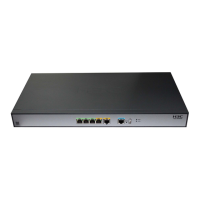3
WLAN Ethernet interface
WLAN Ethernet interfaces are virtual Layer 3 interfaces. They operate like Layer 3 Ethernet
interfaces. You can assign an IP address to a WLAN Ethernet interface. On a wireless router, a
WLAN radio interface bound to a WLAN Ethernet interface operates as a Layer 3 interface.
Entering WLAN Ethernet interface view
Step Command Remarks
1. Enter system view.
system-view
N/A
2. Enter WLAN Ethernet
interface view.
interface wlan-ethernet
interface-number
If the WLAN Ethernet interface
does not exist, this command
creates the WLAN Ethernet
interface first.
3. Specify the expected
bandwidth for the interface.
bandwidth
bandwidth-value
Optional.
4. Restore the default settings
of the WLAN Ethernet
interface.
default
Optional.
Configuring a WLAN Ethernet interface
For a WLAN Ethernet interface, you can configure basic settings such as MTU, ARP, DHCP, and
routing protocols as listed in the following table (for information about the commands/features listed
in the following table, see related chapters in the corresponding volumes).
To configure a WLAN Ethernet interface:
Step Command
5. Configure an interface.
• qos max-bandwidth
• shutdown
• mtu
• description
• enable snmp trap updown
6. Configure ARP.
• arp max-learning-num
• arp proxy enable
• proxy-arp enable
7. Configure the interface as a BOOTP client.
ip address bootp-alloc
8. Configur
e DHCP.
Configure DHCP server
dhcp select server global-pool
Configure DHCP relay
• dhcp relay address-check
• dhcp relay information enable
• dhcp relay information format
• dhcp relay information strategy
• dhcp relay release
• dhcp relay server-select
• dhcp select relay
Configure DHCP client
ip address dhcp-alloc
9. Configure IP accounting.
• ip count firewall-denied

